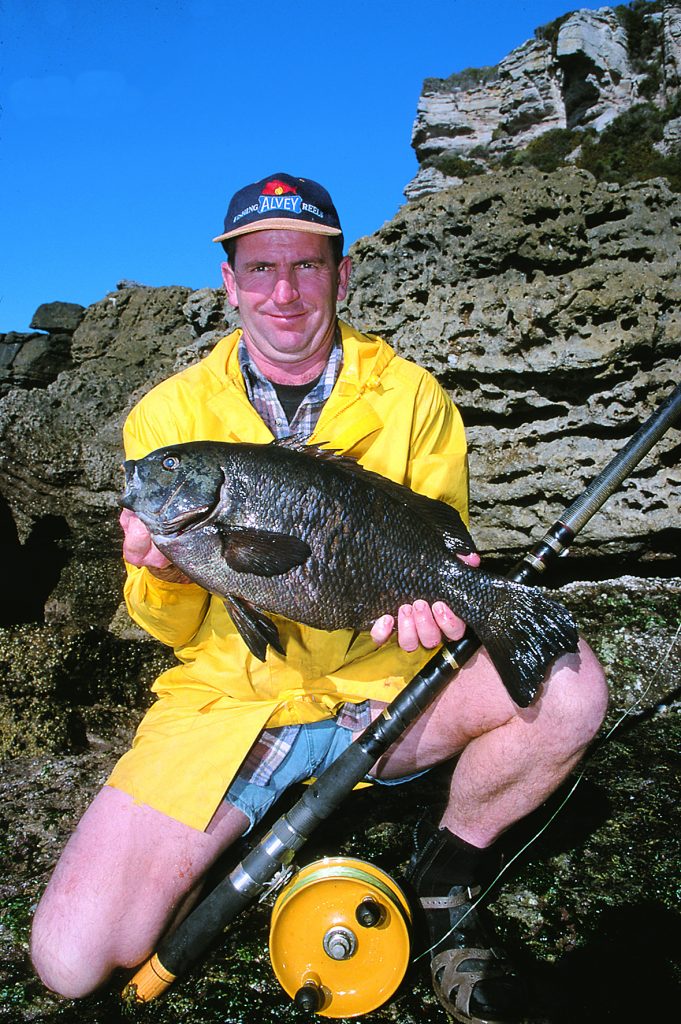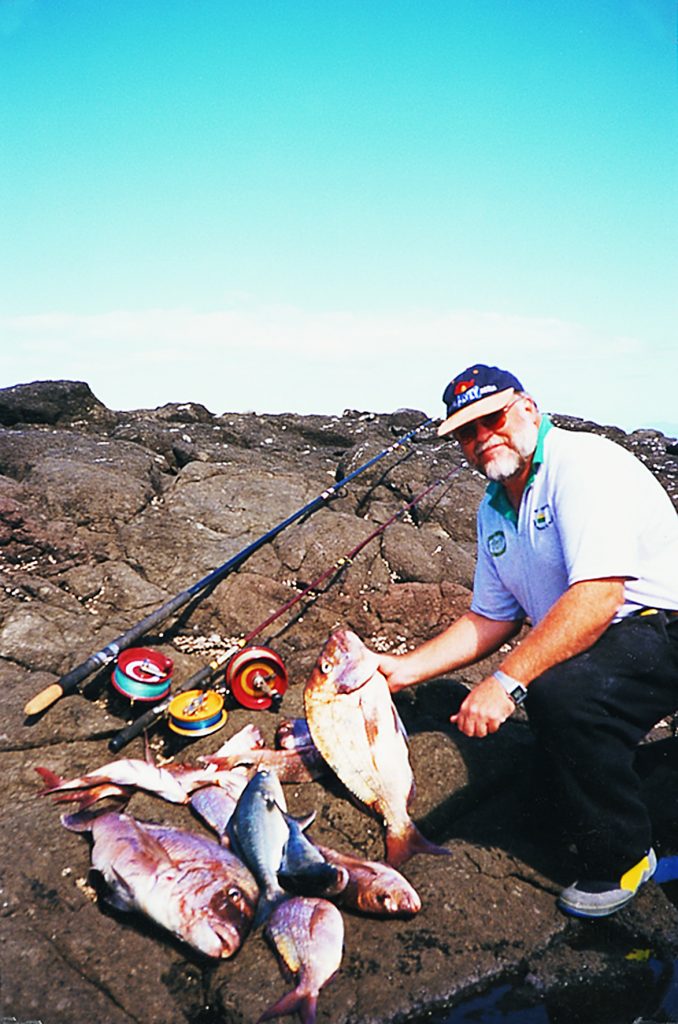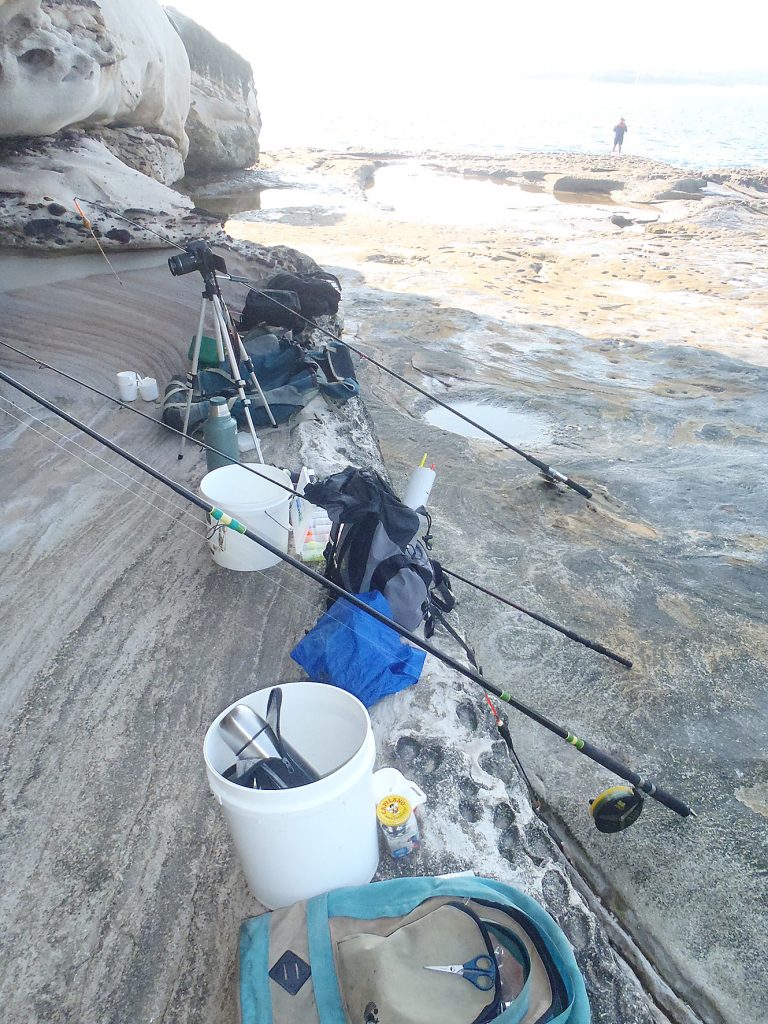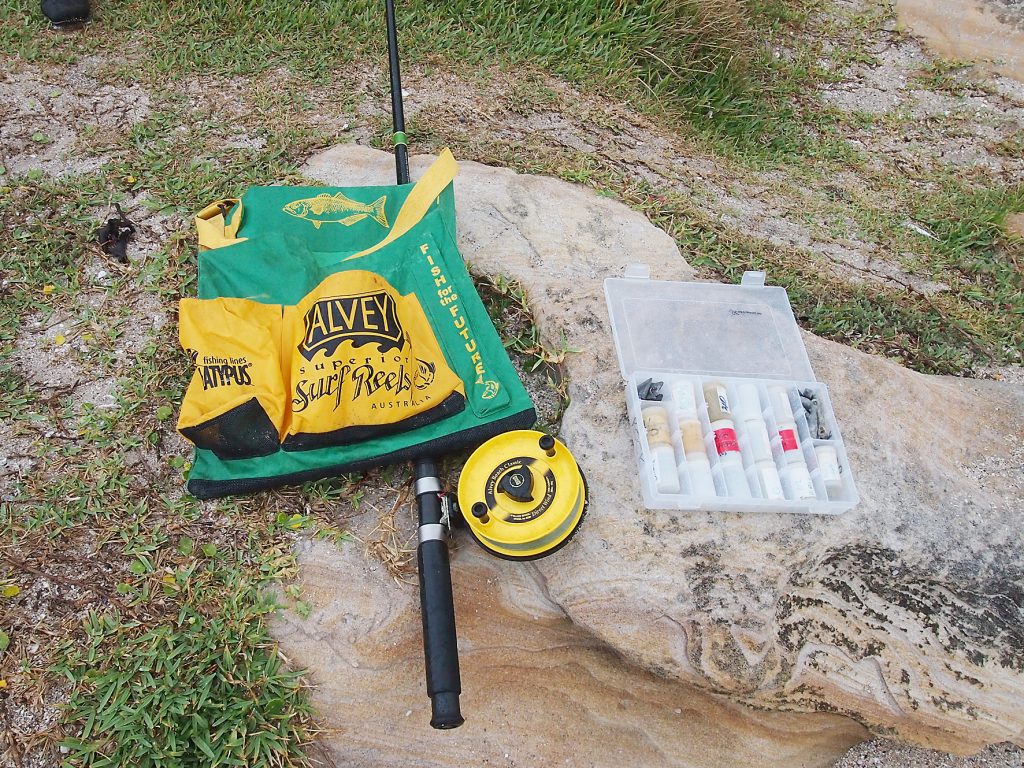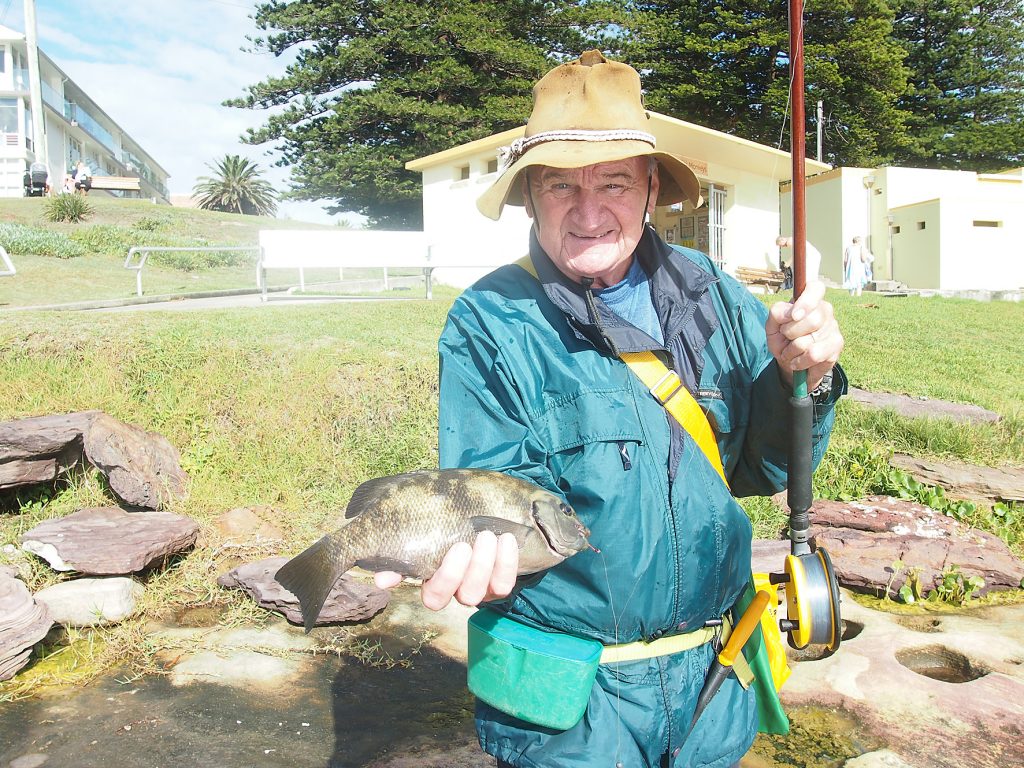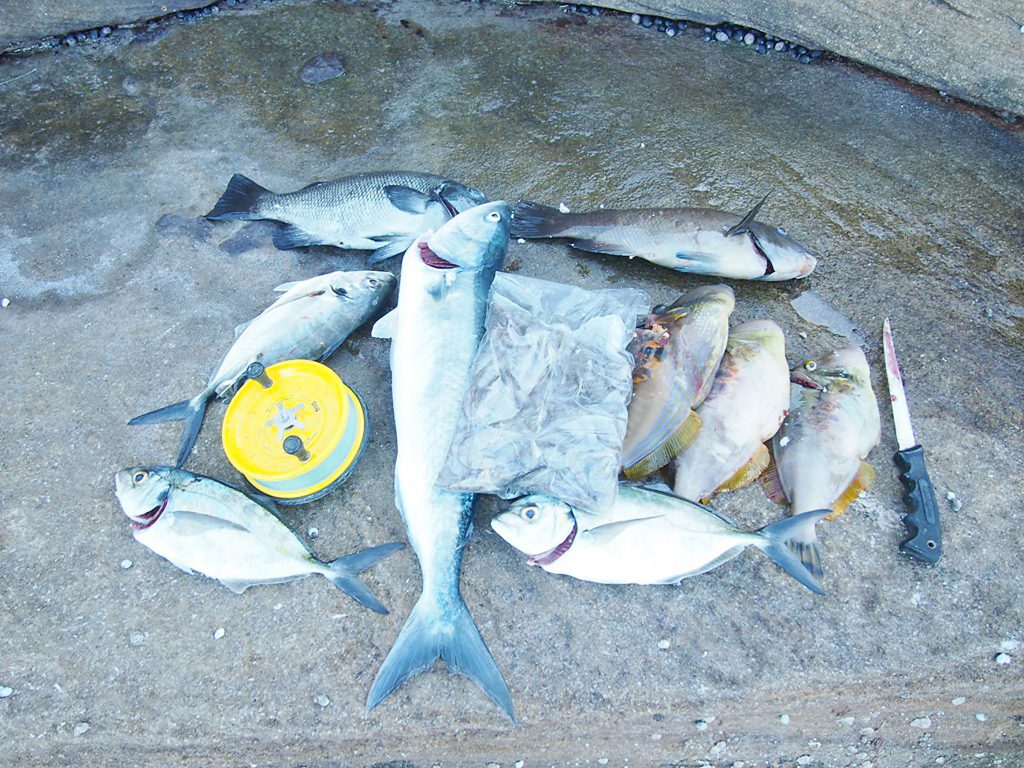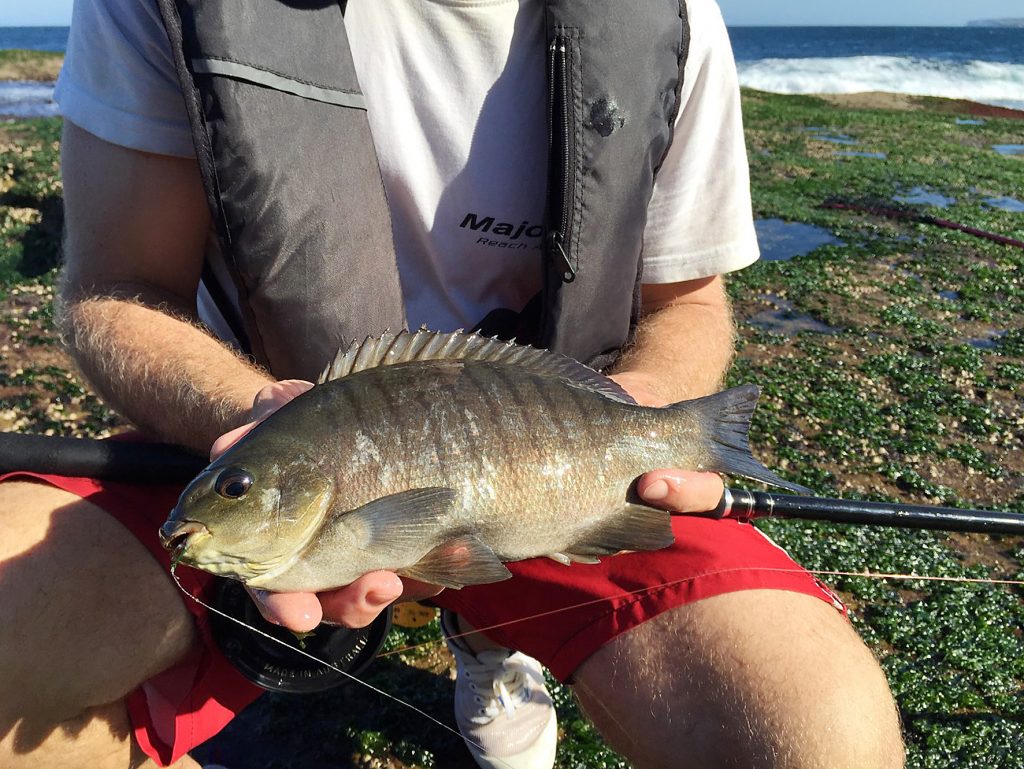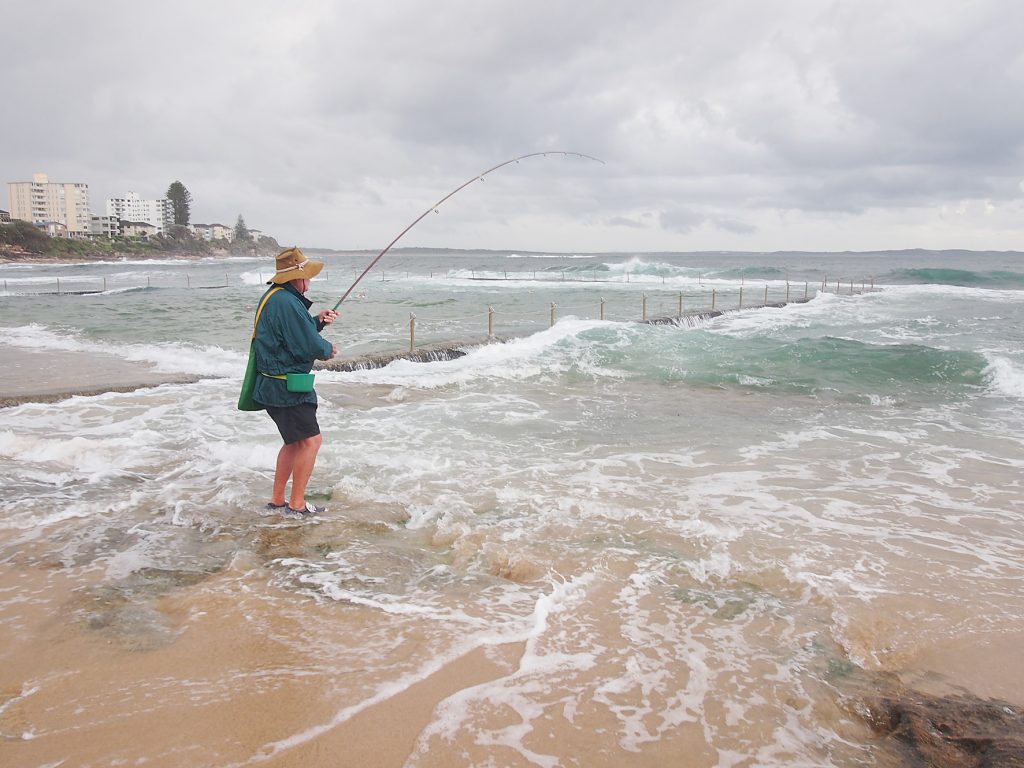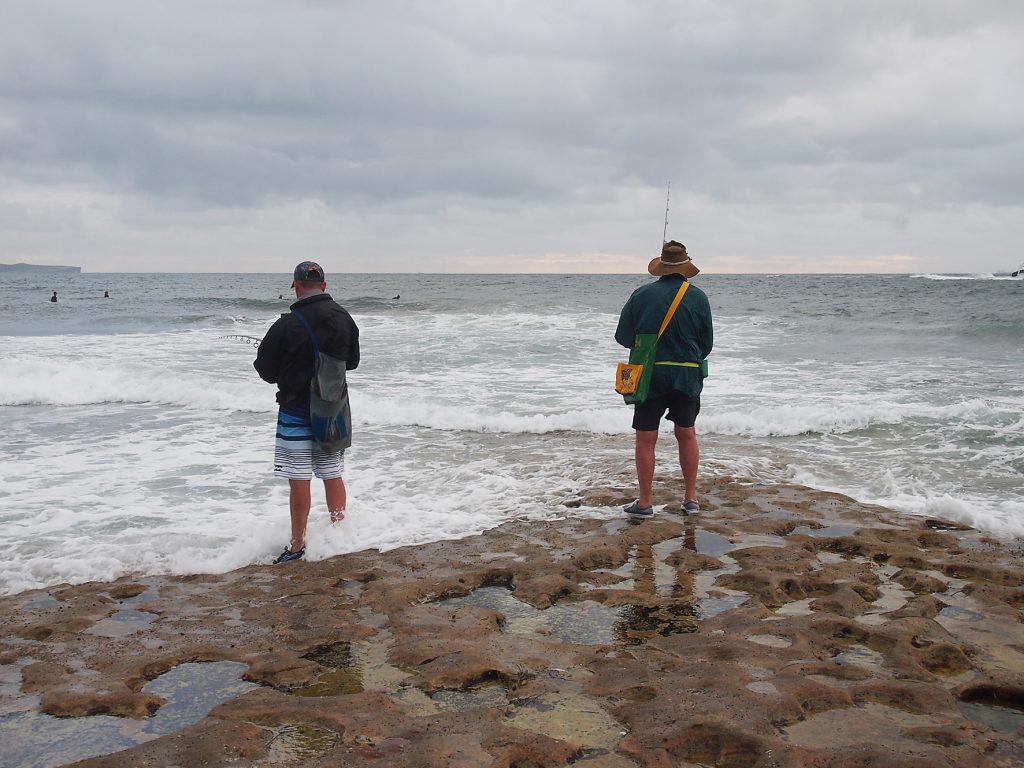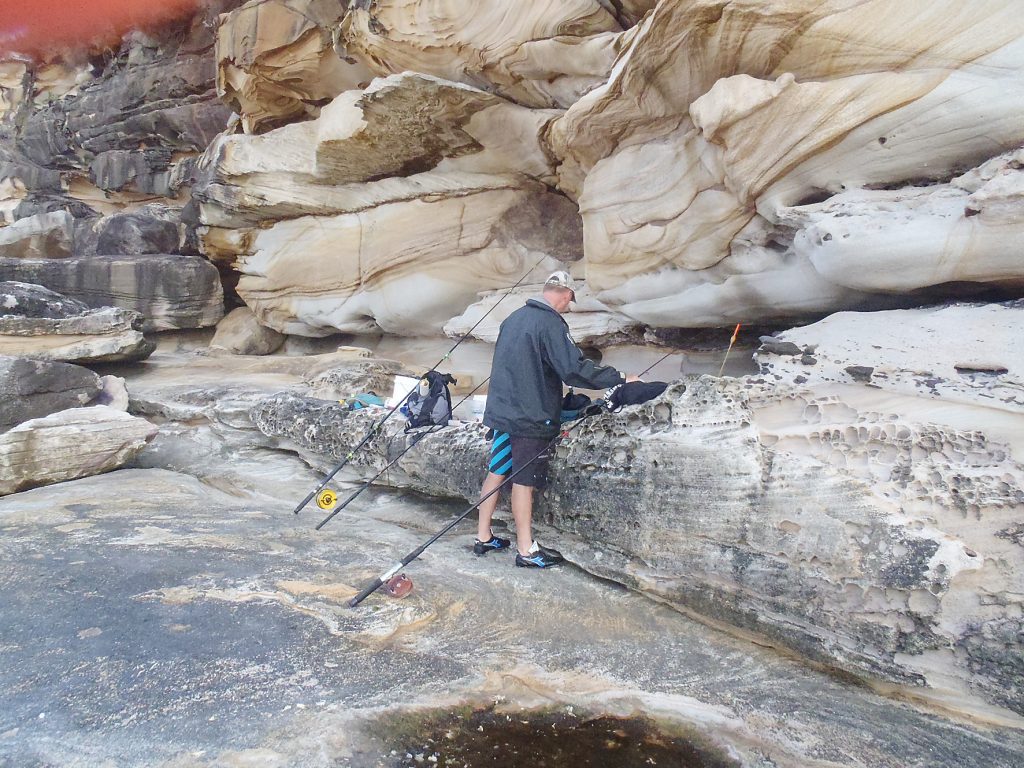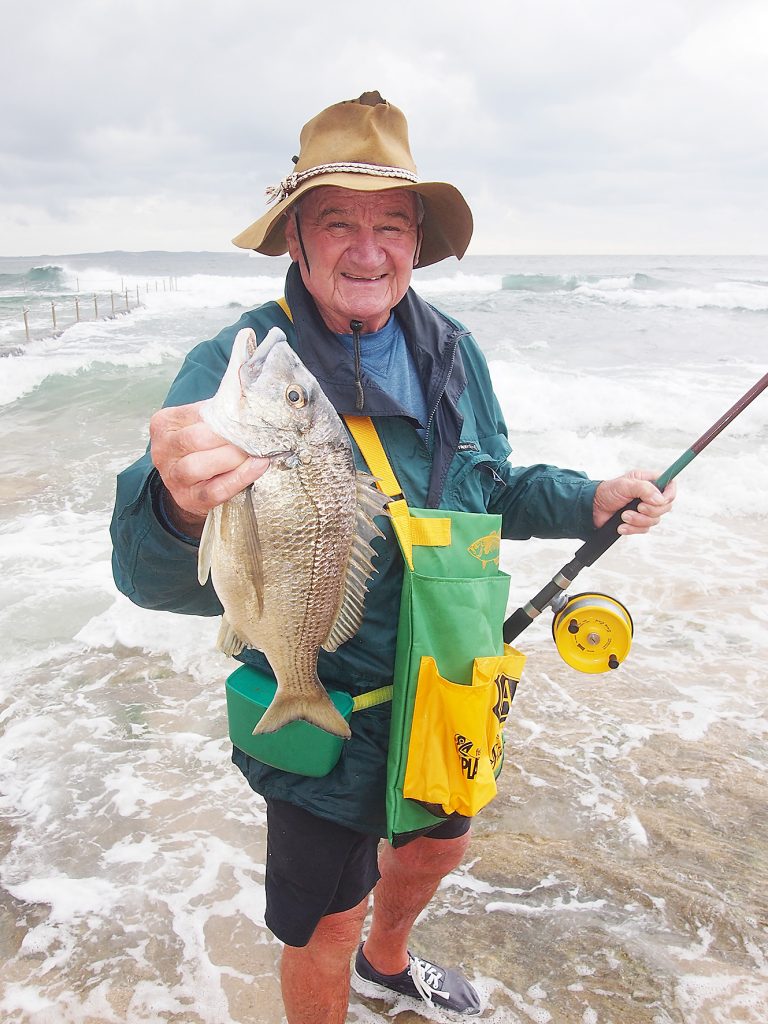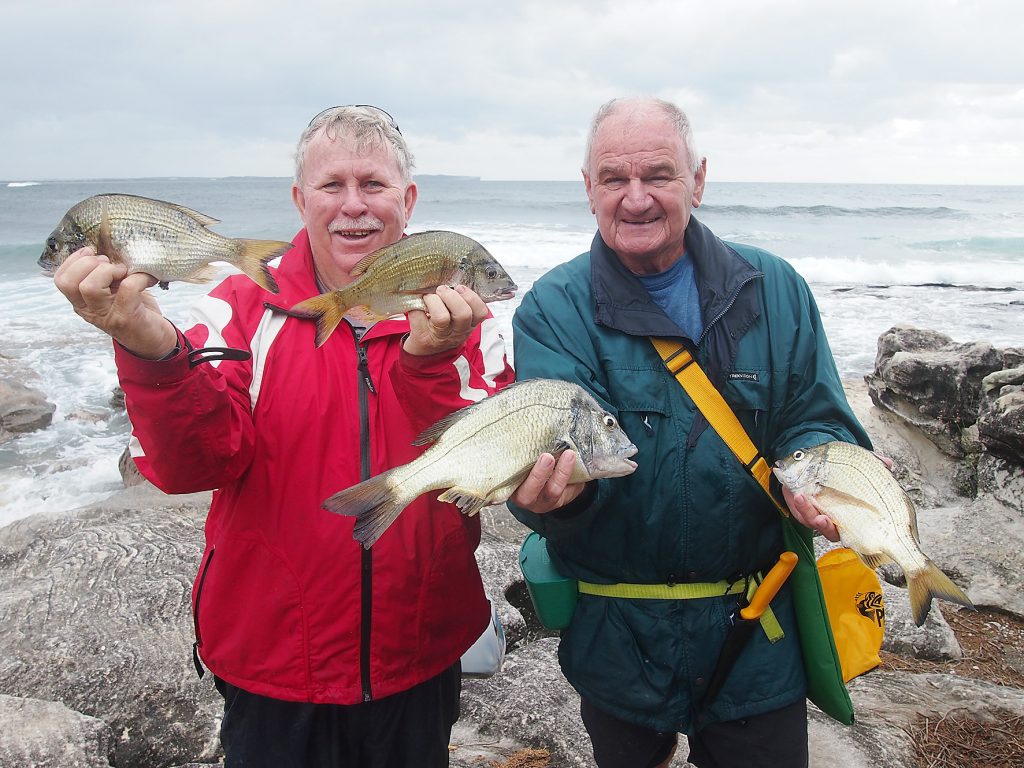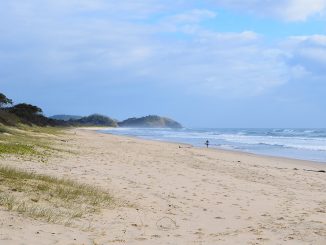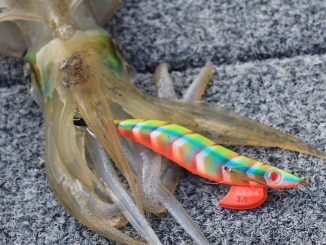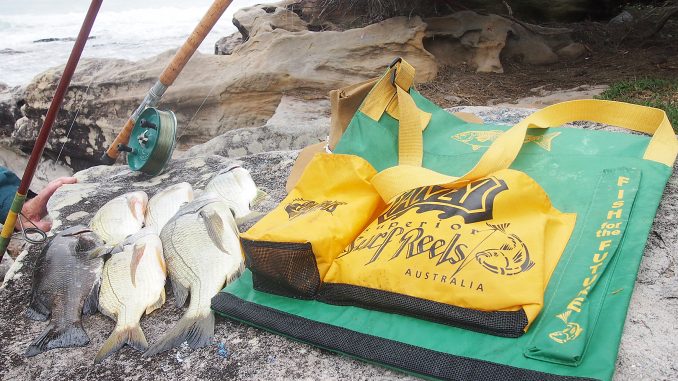
by Gary Brown •
I have been fishing off the rocks since I was a kid, and have learnt so much from the many anglers I have fished with over the years. This knowledge has enabled me to catch Australian salmon, bream, drummer, groper, luderick, mulloway, silver trevally, snapper, squid, tailor and yellowtail kingfish.
In this article I will share some of the important things that I have learnt over the years. We’ll look at the best times to go fishing and, when you are there, some of the critical things to look for. I’ll also discuss the tackle and accessories that I bring, and explain how to maximize your fishing time. Finally, we’ll look at how you can improve your casting and retrieving techniques, and when should you strike to maximise your hook-up rates.
Times to go fishing
Groper can be caught year-round, but I have found that the best time to target them in my area is when there has been an offshore wind for a couple of days. This will usually flatten the seas for a few days and clear up the water, giving you a chance to get closer to the edge, and also make it easier for you to gather those red crabs that groper love to eat. It also means that you don’t usually have to cast as far to get to the fish, giving you less line out in the water for the fish to snag up.
I live on the South Coast of NSW, and there’s a place that I fish which faces the south which can produce throughout the day at all tides (bream, drummer and luderick). At low tide it has about 50cm of water, and if you use a small bobby cork and have the bait suspended about 25cm below it you can still pull fish out. Early in the morning as the sun starts to rise there is still enough shadow on the water to allow the fish to feed in close. Late in the afternoon when the sun has gone behind the cliff and a shadow starts to form, the fish come back into the shallows to feed. When the day is very overcast you can fish right through the day.
When there has been a bit of an onshore blow for a few days and the swell is up too much to fish off the rocks, I wait until the seas have abated slightly so that it is safe to fish. During a rough spell the seas dislodge plenty of food for bream, trevally, drummer, snapper and luderick to snack on under the white water. Berleying with green cabbage and weed for the drummer and luderick, smashed up sea urchins and crabs for the groper and snapper, and bread and old pilchards for the bream and trevally work a treat.
Safety is something that should be on your mind at all times when you are fishing off the rocks. Before you start fishing at your chosen spot, check out the conditions of the swell for 10-15 minutes before you start your fishing. Ideally you want no signs that waves have come over the rocks. At the very least, if they are coming over the rocks, you want to be sure they’re not the kind of waves that could knock you off your feet.
Berley plays an important role when come to fishing off the rocks. It can come in many different forms – bread, chicken pellets, old squashed pilchards, finely chopped green weed or cabbage. Make sure that you berley, as it does make a lot of difference.
It doesn’t matter whether you are fishing in a wash, gutter, off sloping rocks or a flat platform, there needs to be some kind of water movement when fishing for luderick or drummer off the rocks. This comes in the form of the change of tide and the swell. Most of the places that I fish for luderick and drummer off the rocks you will find small tufts of either green, brown or black cabbage. It is this growth that you not only use for bait, but scrape off with the cleats or spikes on your shoes. The swell and tide will carry the berley away from the rocks and hopefully bring the fish to where your float is. You should scrape some off before you start to get your gear rigged, and then every time that you move about on the rocks.
BAIT FISHING
When targeting bream, drummer, silver trevally, snapper and groper off the rocks I use a variety of baits. One option is to thread two half pieces of cunjevoi onto a hook, and push them over the eye of the hook onto the line, then put half a cut crab onto the hook by going through one leg hole and out another on the opposite side. This combination of baits is deadly for drummer, bream and groper. The smaller fish pick at the cunje, creating a bit of berley and commotion, and this attracts the attention of any passing bigger fish. The half crab has the added benefit of helping to hold the cunje onto the hook.
If you are going to use frozen baits, one tip is to have a look at the build-up of ice on the inside of the bags. If there is a lot of ice it means that the bait has been in the freezer for too long or the bag has broken somewhere. This will lead to the bait drying out and getting freezer burn.
A good option is to buy your bait in bulk and then re-package it. As an example, I buy my pilchards as IQF (individually quick frozen) and then put 10-15 in a resealable plastic bag. Then, if I am going for a quick fish off the rocks, I only need to take one bag. This saves a lot of waste and money.
Keep an eye on the water’s surface for baitfish that have been herded to the surface. Cast either a lightly-weighted pilchard or small metal lure around the edges of the school and then retrieve it. If you don’t get a take, allow the pilchard or lure to sink for a few seconds and start your retrieve, as the larger fish are usually below.
WHAT TO BRING
When fishing off the rocks I like to bring as little gear as possible, so that I can move about with ease. To this end, I take only enough tackle for the session, contained in two tackle trays.
The first tray has hooks, swivels, sinkers and a metal or two. I keep them separated in film canisters, but old pill bottles would also be good for this.
The other tray has six compartments in it with six different ganged hook set-ups. They are as follows: 6/0s in sets of three and four hooks, 5/0s in sets of three and four, and 4/0s in sets of three and four. This will help you accommodate different sized baits.
I also wear a belt with a knife, pliers and a bait bucket. Slung across my shoulder is a tailor bag that holds my tackle trays, spare baits and any fish that I catch.
Every time I need to grab another hook or swivel, I spray a couple of shots of Inox or Tackle Guard into the film container where they are kept. This will stop them from rusting and it will not put the fish off from biting.
Maximising fishing time
Berleying can become very tedious at times, and on a few occasions I have gotten so caught up with catching fish that I forget to keep the small and steady berley trail going. You can avoid this by putting your berley into a small meshed bag and tie it close to where you are fishing. Alternatively, you could try using the filleted frame of an oily fish like tuna, bonito, salmon or tailor and tie a rope around the tail, and secure it to the rocks where you are fishing. The filleted frame washes around, causing small pieces to break off every now and then. This berley will go out with the tide and current, drawing the larger predators in closer.
Cubing is not just a technique used by offshore anglers who are fishing for yellowfin tuna – it is also extremely effective off the rocks. The most critical part of cubing is the size of the cubes that you put into the water. For example, if I am targeting bream off the rocks with half pilchards, I will cut the cubes into about 1cm pieces. Just before I cast, I will throw three cubes out into the wash. Every five minutes or so I’ll flick out a couple more pieces.
If I am using tuna or bonito strips off the rocks, I will thin the thickness of the fillet down and then cut up the leftover flesh into small pieces. I throw these small pieces into the water, the same as the pilchard cubes.
CASTING AND RETRIEVING
It is paramount that you are able to cast properly, as this will allow you to cast very lightly-weighted baits like pink nippers and peeled prawns at those times when you need to get a lightly-weighted bait or paternoster rig out wide. This is where you will need to refine your casting techniques.
When I first started out, I went down to the local football field for a couple of hours to perfect my cast. I find that if I have one hand at 90° to the reel and the other hand up as far and comfortably up the rod. My feet are spread apart so that I am balanced. It is just a matter of casting straight over your head so that your left hand will end up just behind you, and your right hand will end up out in front of your body (or the opposite if you are a left hander). Once you have mastered the cast you will be amazed at how far you can cast a bait or lure.
Drummer can live in some very nasty terrain, and can at times be very hard to get out. They love to feed under and around washes, rock ledges, kelp and boulders. This is where the use of a running ball sinker down onto the bait needs to be calculated to suit the conditions. Sometimes you will only need the weight of the bait to help you cast into the wash.
Fishing as light as possible will allow the bait to wash around. When using this method, it is critical that you stay in contact with the bait at all times, and this can be done by slowly winding up any slack and keeping your rod at around 45° to the water’s surface. This will allow you to keep the bait off the bottom, avoids most of the snags, and will also allow you to feel even the smallest of bites and give you enough angle to strike when the fish has taken the bait.
To strike or not to strike?
Trevally can be caught year-round off the rocks in Sydney, and they respond well to a berley trail of either bread, chicken pellets or smashed up pilchards. My preferred baits are medium-sized peeled prawns, half pilchards and skinned pieces of fresh yellowtail. Because silver trevally don’t have teeth as such, they tend to softly suck the bait down. This can sometimes lead to missed hook-ups.
It is best to have a small running ball sinker down onto the bait, and to stay in contact with the bait the whole time. This will mean that you will need to lower and raise the rod tip and at the same time slowly wind in some slack line.
If you feel a slight weight or small bites you will need to lower the rod and allow the trevally to suck in the bait. Once it has started to load up, slowly strike to hook the fish. There have been times when the trevally will pick up the lightly-weighted bait and continue moving on through the berley trail. If you haven’t felt a bite or a slight pull, and you haven’t been snagged, you will need to slowly wind in the line. Once again, when you feel a bit of weight you will need to strike as the fish has most probably swum towards you.
Keep an eye out
If there are other anglers fishing near you, and they are catching fish and you aren’t, try to check out what they are using (without being too intrusive). I remember a time when I was catching mullet alongside an Italian gentleman, and he was out-fishing me at least six to one – even though we both had the same rig, a similar outfit and what looked like the same bait.
When I asked him what he was using for bait, he just shrugged his shoulders. It wasn’t long after that he snapped his rod in two trying to lift out two mullet at once. After trying to tie a stick to the side of his rod with fishing line to act as a splint and not having much luck, I suggested that he try some of my electrician tape. As he took the tape, he stated that he had put crushed up garlic in his dough.
Have you ever seen a whole school of baitfish swimming nervously on the surface of the water? If so, you should cast out either your bait or lure and allow it to sink for a few seconds and then start your retrieve. There is a big possibility that there will be predatory fish herding them up to the top so that they can attack them.
A number of years ago I was taken to a new spot by a good mate Alan Perry at low tide to target drummer, and I was amazed at how much kelp was there. Wondering how we were going to fish this place, I watched as Alan put on a small running ball sinker down onto a peeled blue-tailed prawn, and without hesitation cast it out into the kelp.
Even though it landed high and dry, Alan flicked it off and as it sank a drummer smashed the bait. The 25kg line was used to skull-drag the fish out of the kelp. We proceeded to have a great session that day, and the biggest that we managed to get out pulled the scales down to 4.5kg.
Have you ever been using a whole pilchard on a set of ganged hooks while slowly spinning for tailor, salmon or bonito off the rocks, and felt a small bite that you thought was pickers attacking the bait, only to find that when you retrieved the pilchard you noticed that the guts or a middle section had been bitten out? When that happens it’s time to downsize your hook to a single 1/0 or 2/0, and put on a pilly tail. The culprit that bit the piece out of the whole pilchard could have been a bream or trevally feeding under the school of surface fish.
Alternatively, if you have a ‘V’ section taken out behind the head it usually means there are squid about. Time to get those squid jigs out!
THE AUTHOR’S TOP 3 OUTFITS
1. 12’, 15kg composite rod and 5500 size threadline with 10kg mono
Whether it’s a paternoster rig, running ball sinker onto the bait or a running sinker down onto a swivel and a leader, this outfit will handle it with ease. The rod length gives you that extra casting distance, which is important.
For this kind of fishing I like my rod to have a solid fibreglass tip to give that extra feel when the bites are a bit slow, and if you do hook up to a decent fish you want low-down power to allow you to steer the fish towards you. If you can get a good multi-piece rod, so much the better because you can pack it in your car. My preferred outfit is an Okuma 7.5 to 15kg Flexi Tipz and 5500 Azores threadline.
2. 13’, 10-15kg graphite surf rod and 5500 size threadline with 15kg braid
The length of this rod gives that extra casting distance when it comes to punching out 85-170g lures. This outfit also doubles as a great bait rod where you are fishing with heavier rigs and baits for snapper, groper, salmon and tailor. I use a 3-piece, 10-15kg Okuma Trio Rex Surf Rod and 5500 Azores threadline.
3. Bruce Alvey Special 3-5kg, 3.6m and Alvey Light Surf Elite sidecast reel with 6kg mono
This outfit is perfect for casting unweighted and lightly-weighted half pilchards, large peeled prawns, cunje, strips of bait and lightly-weighted pink nippers for bream, trevally and medium-sized drummer. It can also be used when using a float or bobby cork fishing for luderick, bream, drummer, squid, tailor and salmon.
STAY SAFE
On a final note, the Lifejacket Law has been in place for a while now when fishing off selected areas. In these locations, anglers must wear an appropriate lifejacket. This includes people helping you to rock fish, and children. Failure to wear an appropriate lifejacket while rock fishing in a declared area may result in a $100 on-the-spot fine.
Declared areas currently include Randwick City Council local government area, Northern Beaches Council local government area and Richmond Valley Council local government area, and more areas may be added in the future.
In any case, it is safest to wear a lifejacket whenever and wherever you are rock fishing. For more information on lifejackets and other valuable rock safety tips, go to www.watersafety.nsw.gov.au and click on Rock Fishing Safety.
Good luck!

